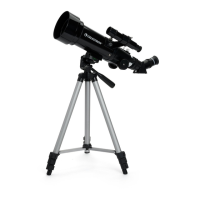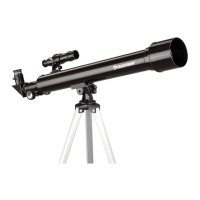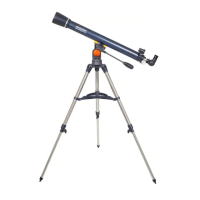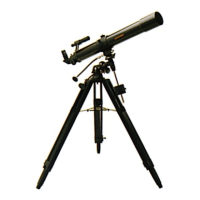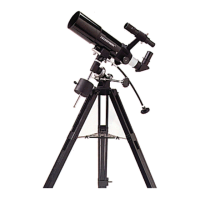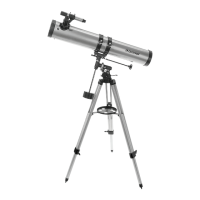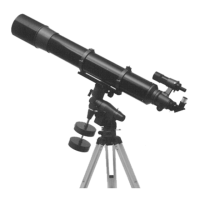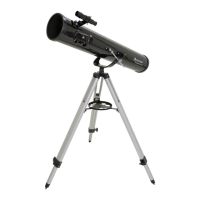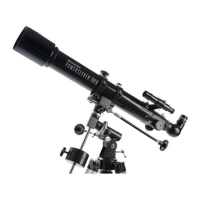Do you have a question about the Celestron 21035 and is the answer not in the manual?
Instructions for extending and adjusting tripod legs for desired height.
Steps to securely mount the telescope optical tube onto the tripod platform.
Explanation of controlling telescope movement using pan handle and locking knobs.
Guide for attaching the diagonal prism and eyepiece to the telescope tube.
Instructions for mounting the finderscope bracket and the finderscope itself.
Steps to align the finderscope with the main telescope for easier targeting.
How to adjust the focus knob to achieve a clear image.
Formula and explanation for determining telescope magnification with different eyepieces.
How to calculate the actual field of view using eyepiece data and magnification.
Advice on optimal conditions and practices for better viewing.
Explanation of R.A. and Declination for locating celestial objects.
How Earth's rotation affects the apparent movement of stars in the sky.
Tips for observing the Moon, including best phases and filter use.
Guidance on viewing planets like Jupiter, Saturn, and Mars.
Crucial safety precautions and methods for observing the Sun.
Introduction to deep-sky objects and optimal viewing conditions.
Technique for finding celestial objects using star patterns as guides, including Andromeda.
Finding M57, using averted vision, and importance of dark locations.
Clarity of the atmosphere affected by clouds, moisture, and particles.
Brightness of the sky from Moon, aurorae, light pollution affecting visibility.
Atmospheric stability affecting image detail and sharpness.
Instructions for cleaning telescope lenses and handling dew build-up.
Instructions for extending and adjusting tripod legs for desired height.
Steps to securely mount the telescope optical tube onto the tripod platform.
Explanation of controlling telescope movement using pan handle and locking knobs.
Guide for attaching the diagonal prism and eyepiece to the telescope tube.
Instructions for mounting the finderscope bracket and the finderscope itself.
Steps to align the finderscope with the main telescope for easier targeting.
How to adjust the focus knob to achieve a clear image.
Formula and explanation for determining telescope magnification with different eyepieces.
How to calculate the actual field of view using eyepiece data and magnification.
Advice on optimal conditions and practices for better viewing.
Explanation of R.A. and Declination for locating celestial objects.
How Earth's rotation affects the apparent movement of stars in the sky.
Tips for observing the Moon, including best phases and filter use.
Guidance on viewing planets like Jupiter, Saturn, and Mars.
Crucial safety precautions and methods for observing the Sun.
Introduction to deep-sky objects and optimal viewing conditions.
Technique for finding celestial objects using star patterns as guides, including Andromeda.
Finding M57, using averted vision, and importance of dark locations.
Clarity of the atmosphere affected by clouds, moisture, and particles.
Brightness of the sky from Moon, aurorae, light pollution affecting visibility.
Atmospheric stability affecting image detail and sharpness.
Instructions for cleaning telescope lenses and handling dew build-up.
| Model | 21035 |
|---|---|
| Optical Design | Refractor |
| Focal Ratio | f/10 |
| Mount Type | Altazimuth |
| Eyepiece 1 | 20 mm (35x) |
| Eyepiece 2 | 10 mm (70x) |
| Finderscope | 5x24 |
| Highest Useful Magnification | 165x |
| Lowest Useful Magnification | 10x |
| Limiting Stellar Magnitude | 11.7 |
| Resolution (Rayleigh) | 1.99 arc seconds |
| Resolution (Dawes) | 1.66 arc seconds |
| Light Gathering Power | 100x |
| Optical Coatings | Fully Coated |
| Aperture | 70 mm |
| Tripod | Aluminum |
| Focal Length | 700 mm (28 in) |
| Tube Length | 27 in (686 mm) |
